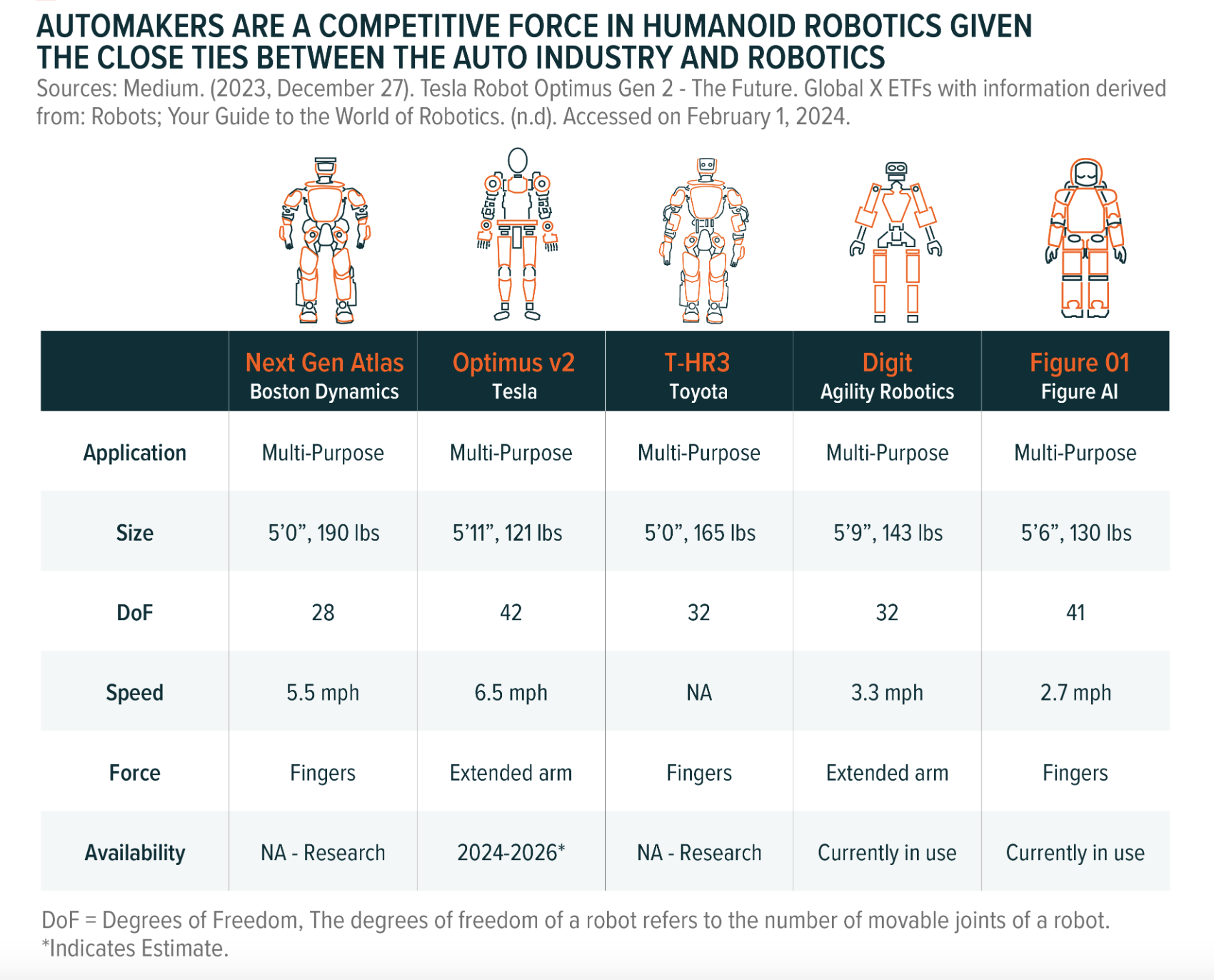The New Robots … the race to create the most advanced humanoid robots, accelerated by AI, enabling humans to be more human … Agility’s Digit vs Boston’s Atlas vs Tesla’s Optimus vs Figure’s 01
February 20, 2024
In the 1400s, Leonardo da Vinci designed a complex mechanical robot clad in a suit of armour, capable of sitting, standing, and independently moving its arms. The entire robot was operated by a system of pulleys and cables. In the 17th to 19th centuries, the Japanese built humanoid automata called karakuri puppets. These puppets resembled dolls and were used for entertainment in theatre, homes, and religious festivals.
Sci-fi movies have captured our imaginations with the cute human-like possibilities of machines – from the tin woodman in 1930’s The Wizard of Oz, to droid friends C-3PO and R2-D2 in Star Wars of 1977.
Real world examples of humanoid robots have included Honda’s Asimo, which was launched in 2000 to demonstrate new technological advancements of intelligent machines. And in 2016 Sophia, a humanoid robot developed by Hanson Robotics in Hong Kong was physically modelled on Audrey Hepburn, adding artificial intelligence, visual data processing and facial recognition.
AI-enabled robots
The prospects for machines that help with everything from serving coffee to folding laundry, carrying boxes in warehouses to handling hazardous waste, caring for the elderly to fighting on the battlefield, have improved as progress in AI accelerates and investment in humanoid robots grows faster than anticipated.
“Humanoids” are advanced robotic machines capable of emulating human actions, reasoning, and operations. They represent the convergence of technologies like AI, biomechanics, machine learning, and sensor connectivity with learning, cognitive development, and behavioral studies. Humanoids are crafted to mimic the human shape, aligning with the human-centric design of our world, from tools to building to homes.
The worldwide market for humanoid robots is forecast to be bigger than analysts in Goldman Sachs Research expected even a year ago, are currently having most impact logistics, manufacturing, healthcare and hospitality, but their use is still limited, and development costs are high. The total addressable market is projected to reach $38 billion by 2035.
Supporting this accelerated growth, the manufacturing cost of humanoid robots has dropped from a range that ran between an estimated $50,000 (for lower-end models) and $250,000 (for state-of-the art versions) per unit last year, to a range of between $30,000 and $150,000 now.
Robot Makers
Prominent companies driving the humanoid robotics field include established players like Boston Dynamics, Tesla, and Toyota, and startups like Agility Robotics and Figure, with each company bringing a distinct focus.

Boston Dynamics’s Atlas, its most advanced humanoid robot, launched in 2013 as part of the DARPA Robotics Challenge, has recently been updated it with an all-electric version. With its bipedal agility, human-like movement, autonomous navigation, and robust learning abilities, Atlas has gained widespread industry acclaim and has become an internet sensation. Atlas features whole-body skills for swift, dynamic movements, allowing it to lift and carry objects, perform complex exercises like jumping and backflips, and participate in disaster response and industrial tasks that demand dexterity and adaptability.
Tesla’s Optimus Gen 2, is in development for commercial purposes. It is a versatile, general-purpose machine capable of assisting in multiple domains, including manufacturing, construction, healthcare, and entertainment. The robot offers precise, flexible movement capabilities, and its hands, equipped with 11 degrees of freedom, feature tactile sensors and high-speed actuators, enhancing its object manipulation skills. Optimus runs on the same neural networks powering Tesla’s cars, and the company’s expertise in battery technology, sensing, and computing is expected to allow it to operate more cost-effectively than competitors. CEO Elon Musk stated that the prototype could cost only $20,000 upon launch.
Agility Robotics’s Digit the first human-centric, multi-purpose robot made for logistics work has been adopted by Amazon. Digit is designed from the ground up to go where people go and do useful work safely in spaces designed for people, starting with bulk material handling within warehouses and distribution centers. Digit’s “backward” legs unlock the ability to maneuver in tight spaces and get closer to shelves, conveyors, and other infrastructure. The unique design also allows Digit to reach deeper and maintain an operational pick range from the floor all the way up to nearly 6 feet.
Figure AI’s 01 has demonstrated the first fruit of its collaboration with OpenAI to enhance the capabilities of humanoid robots, conversing in real-time. Figure AI raised $675 million from investors including Jeff Bezos, Nvidia, Microsoft and OpenAI. Founded in 2022, it has developed a general-purpose robot, called Figure 01, that looks and moves like a human. The robot, attached to a tether, walks on two legs, and uses its five-fingered hands to pick up a plastic crate, then walks several more steps before placing the box on a conveyor belt.
Engineered Arts’s Ameca, has a silicon face and is equipped with sensors that can track a person or object’s movement. It’s able to express astonishment and surprise, and can recognise faces and voices. Ameca also yawns and shrugs, and can discern emotions and even age. It can also shush you if you’re being too loud. Engineered Arts is based in Cornwall, southwest England. Ameca is currently associated with UAE’s Museum of the Future’s robotic family in Dubai, where it can interact with visitors.
Nvidia’s Project GROOT has developed an innovative general-purpose foundation model specifically designed for humanoid robots, aiming to revolutionize robot learning both in simulation and the real world . By supporting leading humanoid robot makers like 1X Technologies, Agility Robotics, and Boston Dynamics, Nvidia’s Project GROOT stands as a pivotal AI platform that promises to enhance how robots understand natural language and emulate human movements.
Top 22 Humanoid Robots Right Now, according to BuiltIn

More from the blog